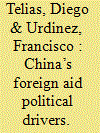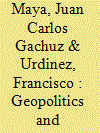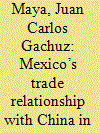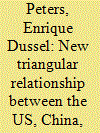|
|
|
Sort Order |
|
|
|
Items / Page
|
|
|
|
|
|
|
| Srl | Item |
| 1 |
ID:
187157


|
|
|
|
|
| Summary/Abstract |
This study investigates a novel dataset comprised of a universe of 537 donations in 33 countries in Latin America and the Caribbean, between 11 February and 20 June 2020, which provides a high level of detail on China’s and Taiwan’s mask diplomacy. We describe who the main donors were, who the main recipients were, what was donated to each country, and which variables explain why some countries received more aid than others. Drawing on previous literature, the article advances understanding about the political determinants of these donations. Our findings revealed that, although seemingly uncoordinated, donations made by China’s central government, Chinese companies, cities, and foundations were strongly affected by two political determinants, namely the recipient’s partnership status with China and the One China Policy. Furthermore, aid provided by China’s Central Government was larger in autocracies than in democracies.
|
|
|
|
|
|
|
|
|
|
|
|
|
|
|
|
| 2 |
ID:
187153


|
|
|
|
|
| Summary/Abstract |
When China invited the Latin American countries to participate in the Belt and Road Initiative, it fuelled expectations of a much closer and more productive relationship with the region. In practice, however, there is little evidence that this was happening even before the coronavirus disease 2019 pandemic. The article shows that neither the policy statements by China nor the trends in economic relations indicate a substantive change in Sino–Latin American relations and that the Belt and Road Initiative represents a repackaging of existing relations and the continuation of trends that have been underway since the global financial crisis.
|
|
|
|
|
|
|
|
|
|
|
|
|
|
|
|
| 3 |
ID:
187158


|
|
|
|
|
| Summary/Abstract |
China began to accelerate the energy transition in the last decade as a strategy for rebalancing its economy and becoming a more influential actor in the global renewable energy market. This article explores to what extent Chinese investment and financing in renewable energy projects in Argentina and Brazil promote these countries' energy transition strategies and sustainable development more broadly. To approach this question, the article provides a reading of Ostrom’s postulates of the energy transition as an increasingly relevant driver of certain states’ relationships with other countries. General trajectories of Chinese investment and lending in Latin America provide a background to Chinese investment in solar and wind power projects in Argentina and Brazil. The article concludes that China’s overseas finance merges with Argentina and Brazil’s own goals regarding renewable energy deployment and discusses future challenges in the context of the COVID-19 pandemic and its aftermath.
|
|
|
|
|
|
|
|
|
|
|
|
|
|
|
|
| 4 |
ID:
187152


|
|
|
|
|
| Summary/Abstract |
The Bretton Woods institutions have failed to accommodate a rising China, and many authors describe this moment as a crisis of the liberal order, which China is intentionally contesting. The World Trade Organization was incapable of offering a solution to the trade war, and more recently, the World Health Organization was incapable of reducing – and rather partly contributed to – tensions between the US and China in the management of COVID-19 crisis. This Special Issue is made up of six manuscripts that address the most sensitive issues of the China–Latin American relationship amid the challenges of the growing dispute with the United States. The manuscripts assess the four main concerns that are shaping the agenda in China–Latin American relations in times of increasing geopolitical and geoeconomic competition between the United States and China: the Belt and Road Initiative, the One-China policy, the trade war, and the COVID-19 crisis.
|
|
|
|
|
|
|
|
|
|
|
|
|
|
|
|
| 5 |
ID:
187156


|
|
|
|
|
| Summary/Abstract |
The Mexico–China economic relationship is highly asymmetric, although the amount of total trade between the two countries has grown rapidly in the last ten years. Chinese exports to Mexico have grown exponentially and have diversified into different economic sectors. In contrast, Mexican exports to China have also grown but at a much slower pace and the pattern shows more concentration in fewer products. Paradoxically, in the context of the United States–China trade war, the Mexican economy has benefitted from the increase in tariffs that the United States has imposed on Chinese products. In 2019, for the first time, Mexico displaced China as a main trade partner of the United States. In this context, this article analyses the current economic relationship of Mexico with China and the United States in a triangular scheme, the impact of the United States–Mexico–Canada Agreement on the China–Mexico relationship, and Mexico's trade relationship with both economies in the context of the trade war.
|
|
|
|
|
|
|
|
|
|
|
|
|
|
|
|
| 6 |
ID:
187155


|
|
|
|
|
| Summary/Abstract |
During 2000–2019, the autoparts-automobile global value chain (AAGVC) underwent significant structural changes from a number of perspectives: micro, meso, or inter-firm relations, macroeconomic, and territorial shifts. This document will focus on recent trade debates on the “new triangular relationship” between the US–China and Latin America and the Caribbean (LAC), and Mexico, and specifically on trade in the AAGVC during 2000–2019. In addition to the discussion on global value chains (GVCs) and its implications, the document analyses in detail qualitative and quantitative global changes in the AAGVC and specifically in US imports during 2000–2019, highlighting the performance of Mexico and China in trade, tariffs, and transportation costs. Conclusions include a set of future research topics.
|
|
|
|
|
|
|
|
|
|
|
|
|
|
|
|
| 7 |
ID:
187154


|
|
|
|
|
| Summary/Abstract |
This article examines how the Chinese elites are interpreting China’s growing presence in the Latin American and Caribbean (LAC) region and the various ways in which the United States is responding to China’s expanding activity in the region. Some of China’s elites caution that China’s international posturing could be overly assertive. Regarding China’s growing role in the LAC, they have made a note of US sensitivities, in addition to China’s challenges and limitations in various Latin American countries. Regarding the US response, some US concerns may be legitimate, and others are less valid. Looking ahead, even though US–China interactions in the LAC will remain competitive, the US and China could potentially avoid counterproductive policies while also pursuing pragmatic co-operation. While China does not yet face a serious problem of strategic overstretching in the LAC, China’s domestic debate on the topic will provide feedback to China’s policymakers and promote fruitful China–LAC relations.
|
|
|
|
|
|
|
|
|
|
|
|
|
|
|
|
|
|
|
|
|